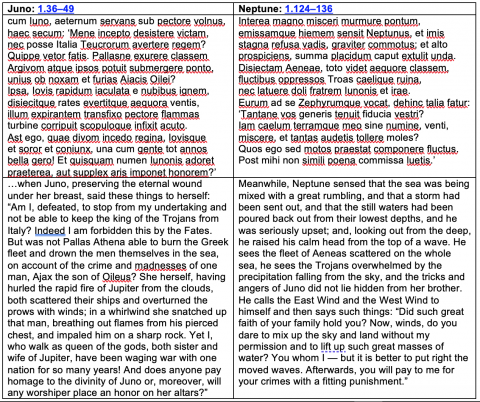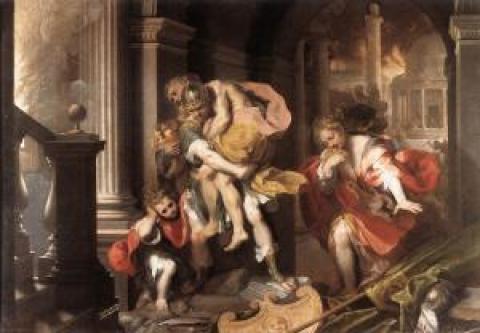Lindsay Herndon
August 22, 2022
Vergil’s characters in the Aeneid have always been symbolic of more than their narrative roles and actions. I have found Vergil’s depictions of women figures ever more intriguing as I have read and re-read the Aeneid. So, for my M.A. thesis in Latin Literature, defended at Kent State University in Fall 2021, I investigated patterns of difference in Vergil’s depictions of women and men.
In contrast to his men figures, Vergil depicts his women figures using elegiac and tragic motifs and bases them on elegiac, tragic, Hellenistic, Callimachean, and Catullan models. Vergil uses women as foils for Aeneas’ character and as obstacles to Aeneas’ mission. Sharon James argues:
The sacrifice of its most gripping character [Dido] is one of the ways the Aeneid marks the nature of Rome’s imperial future as requiring the subordination of personal passions to greater public causes.…Even after Aeneas has broken off with her, Dido’s passions are seen as endangering his mission.
Similarly, John P. Sullivan argues, “Woman — the Other — whether Creusa, the disheartened Trojan women in Sicily, Dido or Cleopatra, should be construed as an obstacle to the fulfilment of Man’s creative vision and goals, whether political, artistic, or moral.”
Sullivan is not alone in viewing women figures in Aeneid as temptations Aeneas must “conquer” in order to achieve his mission. Scholars of Augustan literature, and especially elegiac poetry, argue that anti-feminine ideologies cause Augustan writers, including Vergil, to frame women in their texts as deviant and dangerous figures.
Working with elegiac conventions, Vergil consistently portrays women as controlled by furor, madness characterized by lack of control and excess. According to Sarah Spence, Juno is the embodiment of this characteristic in the Aeneid and thus stands “for conflict and disagreement with everything Aeneas comes to represent.” Charles Saylor believes that this characteristic applies also to Dido, where her furor is manifested as a type of maddened and excess love.
When in the grips of furor, Vergil’s women are depicted both by an excess of emotion and by making decisions with the intent of satisfying an individual need, whereas his men make decisions that value pragmatics and communal value, rather than emotions and individual desires. Dido’s presence in the narrative exists primarily to emphasize Aeneas’ pietas; it is Aeneas’ ability to ignore his feelings for the good of his people and mission that earns him this description.
To further illustrate the differences between Vergil’s depiction of women characters as excessively emotional and motivated by individual gain and his men as able to maintain control and motivated by pragmatics and communal need, I have chosen two well-known passages from Book 1 (translations mine):

Figure 1: Table featuring two passages in Latin and English from the Aeneid: Juno's speech at 1.36-49 and Neptune's at 1.124-136.
In these passages, we can see a marked difference between the representation of women and men. Juno’s passage is characterized by a focus on the individual. It is she who has been rejected and who worries that her own individual honor has been disrespected. On the other hand, Neptune has also been disrespected because the winds have infiltrated his sphere of power. Like Juno, he is very angry (graviter commotus), but he is able to put aside his own desire for revenge until after he has fixed the precarious situation (sed motos praestat componere fluctus). Nicholas Horsfall (“Dido in the Light of History,” in Fifty years at the Sibyl’s Heels: Selected Papers on Virgil and Rome) also makes the point that Neptune is quelling a storm caused by Juno’s anger and “[his] calming of the waves is compared to a riotous mob, inspired by furor, falling silent at the sight of a statesman pietate gravem ac meritis (1.150–151)” (14). Sarah Spence argues that “The association of reason with power through language [in Neptune’s speech] is diametrically opposed to the furor and powerlessness associated with Juno’s speech.”
Vergil applies the motif of furor to many women figures in the Aeneid, but in the case of Juno, he not only depicts her as ruled by furor, but also as a sort of divine source of furor, which she transfers to other characters. James argues that “[Juno’s] failure [of controlling passion] sets the pattern for other women’s obstructionist behavior.…Men too are overcome by passion (usually in battle), and Turnus is likewise infected by Allecto at Juno’s behest.” According to Horsfall, Dido comes under the control of furor through the plot of Juno, who is also Dido’s patron goddess. When we first see Dido, she is in the temple of Juno (1.505–506), and the plot of Juno and Venus causes Dido to fall in love with Aeneas (4.90–104). Horsfall also argues that “This combination of Juno and madness recurs again in the burning of the ships in Aeneid 5, in the Allecto-scenes in Aeneid 7 and in the burning of the ships in Aeneid 9: each time it stands opposed to Aeneas and Rome.”
In conclusion, the consistency with which Vergil depicts his women figures in the grips of powerful emotions and as obstacles to Aeneas is quite significant. The fact that he uses infamous figures such as Phaedra or Medea as models and deploys Catullan as well as elegiac motifs for these figures supports my claim that he wanted to show them as emotional and lacking the control and judgment he attribuets to his male figures, such as Neptune and Aeneas.
It is also worth noting that Vergil does not depict all women in this way. Grace Starry West notes that Creusa and Venus are notable exceptions, because both appear to him in book 2 to “curb his furor” and direct him back to correct actions. Alison Keith also argues that it was Creusa who “offers the spirited objection to Aeneas’ abnegation of his responsibilities to his family that stops the hero from further futile fighting in Troy (2.671–678) and thereby ensures that he witnesses the portent of the flame that encircles Iulus’ temples (2.679–686) and finally convinces the reluctant Anchises to leave Troy (2.687–704).” Some scholars with more jaded views, such as Sullivan (“Dido and the Representation of Women in Vergil’s Aeneid,” in The Two Worlds of the Poet: New Perspectives on Vergil) and Clausen argue that it is significant that both Dido and Creusa must be lost in the course of Aeneas’ mission.
When it comes to Venus, I disagree with West’s claim: Vergil’s portrayal of Venus is more nuanced because, at times, she seems to oppose Aeneas’ mission and at other times seems to be trying to aid Aeneas. Horsfall argues that, while she could be seen as acting emotionally, which would be furor, Vergil often depicts her as a protective mother rather than an obstacle blocking Aeneas’ mission. Once she is assured by Jupiter of Aeneas’ success, she allows him to proceed on his mission and even aids him in procuring the golden bough in Book 5 and divine armor in Book 8. It is also significant to remember that, because of the familial connections of Venus in imperial propaganda (as famously demonstrated by Paul Zanker), Vergil had to be particularly cautious with her depiction.
Do you want to write a spotlight on your dissertation or thesis, or want to recommend someone to do one on theirs? Get in touch with the SCS Blog’s Editor-in-Chief, T. H. M. Gellar-Goad.
Header image: Aeneas fleeing a burning Troy, by Federico Barocci. Image courtesy of Wikimedia Commons.
Authors


